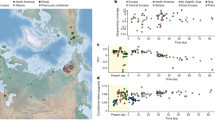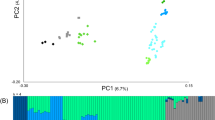Abstract
Advances in genome technology have facilitated a new understanding of the historical and genetic processes crucial to rapid phenotypic evolution under domestication1,2. To understand the process of dog diversification better, we conducted an extensive genome-wide survey of more than 48,000 single nucleotide polymorphisms in dogs and their wild progenitor, the grey wolf. Here we show that dog breeds share a higher proportion of multi-locus haplotypes unique to grey wolves from the Middle East, indicating that they are a dominant source of genetic diversity for dogs rather than wolves from east Asia, as suggested by mitochondrial DNA sequence data3. Furthermore, we find a surprising correspondence between genetic and phenotypic/functional breed groupings but there are exceptions that suggest phenotypic diversification depended in part on the repeated crossing of individuals with novel phenotypes. Our results show that Middle Eastern wolves were a critical source of genome diversity, although interbreeding with local wolf populations clearly occurred elsewhere in the early history of specific lineages. More recently, the evolution of modern dog breeds seems to have been an iterative process that drew on a limited genetic toolkit to create remarkable phenotypic diversity.
This is a preview of subscription content, access via your institution
Access options
Subscribe to this journal
Receive 51 print issues and online access
$199.00 per year
only $3.90 per issue
Buy this article
- Purchase on Springer Link
- Instant access to full article PDF
Prices may be subject to local taxes which are calculated during checkout


Similar content being viewed by others
References
Liti, G. et al. Population genomics of domestic and wild yeasts. Nature 458, 337–341 (2009)
Sutter, N. et al. A single IGF1 allele is a major determinant of small size in dogs. Science 316, 112–115 (2007)
Savolainen, P., Zhang, Y. P., Luo, J., Lundeberg, J. & Leitner, T. Genetic evidence for an East Asian origin of domestic dogs. Science 298, 1610–1613 (2002)
Parker, H. et al. Genetic structure of the purebred domestic dog. Science 304, 1160–1164 (2004)
Vilà, C., Maldonado, J. & Wayne, R. Phylogenetic relationships, evolution, and genetic diversity of the domestic dog. J. Hered. 90, 71–77 (1999)
Pritchard, J., Stephens, M. & Donnelly, P. Inference of population structure using multilocus genotype data. Genetics 155, 945–959 (2000)
Parker, H. et al. Breed relationships facilitate fine-mapping studies: a 7.8-kb deletion cosegregates with Collie eye anomaly across multiple dog breeds. Genome Res. 17, 1562–1571 (2007)
Wilcox, B. & Walkowicz, C. The Atlas of Dog Breeds of the World 5th edn (TFH Publications, 1995)
American Kennel Club. The Complete Dog Book 20th edn (Ballantine Books, 2006)
Vilà, C., Seddon, J. & Ellegren, H. Genes of domestic mammals augmented by backcrossing with wild ancestors. Trends Genet. 21, 214–218 (2005)
Pang, J. et al. mtDNA data indicate a single origin for dogs south of Yangtze river, less then 16,300 years ago, from numerous wolves. Mol. Biol. Evol. 26, 2849–2864 (2009)
Conrad, D. et al. A worldwide survey of haplotypes variation and linkage disequilibrium in the human genome. Nature Genet. 38, 1251–1260 (2006)
Jakobsson, M. et al. Genotype, haplotype and copy-number variation in worldwide human populations. Nature 451, 998–1003 (2008)
Li, J. et al. Worldwide human relationships inferred from genome-wide patterns of varition. Science 319, 1100–1104 (2008)
Boyko, A. et al. Complex population structure in African village dogs and its implication for inferring dog domestication history. Proc. Natl Acad. Sci. USA 106, 13903–13908 (2009)
Dayan, T. Early domesticated dogs of the Near East. J. Archaeol. Sci. 21, 633–640 (1999)
Germonpre, M. et al. Fossil dogs and wolves from Palaeolithic sites in Belgium, the Ukraine and Russia: osteometry, ancient DNA and stable isotopes. J. Archaeol. Sci. 36, 473–490 (2009)
Verginelli, F. et al. Mitochondrial DNA from prehistoric canids highlights relationships between dogs and South-East European wolves. Mol. Biol. Evol. 22, 2541–2551 (2005)
Leonard, J. et al. Ancient DNA evidence for Old World origin of New World dogs. Science 298, 1613–1616 (2002)
Sabeti, P. et al. Genome-wide detection and characterization of positive selection in human populations. Nature 449, 913–918 (2007)
Innan, H. & Kim, Y. Pattern of polymorphism after strong artificial selection in a domestication event. Proc. Natl Acad. Sci. USA 101, 10667–10672 (2004)
Balschun, D. et al. Deletion of the ryanodine receptor type 3 (RyR3) impairs forms of synaptic plasticity and spatial learning. EMBO J. 18, 5264–5273 (1999)
Cruz, F., Vilà, C. & Webster, M. The legacy of domestication: accumulation of deleterious mutations in the dog genome. Mol. Biol. Evol. 25, 2331–2336 (2008)
Gray, M. et al. Linkage disequilibrium and demographic history of wild and domestic canids. Genetics 181, 1493–1505 (2009)
Candille, S. et al. A β-defensin mutation causes black coat color in domestic dogs. Science 318, 1418–1423 (2007)
Cadieu, E. et al. Coat variation in the domestic dog is governed by variants in three genes. Science 326, 150–153 (2009)
Parker, H. et al. An expressed Fgf4 retrogene is associated with breed-defining chondrodysplasia in domestic dogs. Science 325, 995–998 (2009)
Pedrosa, S. et al. Evidence of three maternal lineages in near eastern sheep supporting multiple domestication events. Proc. R. Soc. Lond. B 272, 2211–2217 (2005)
Elsik, C. et al. The genome sequence of taurine cattle: a window to ruminant biology and evolution. Science 324, 528–532 (2009)
Anderson, T. et al. Molecular and evolutionary history of melanism in North American gray wolves. Science 323, 1339–1343 (2009)
Macdonald, D. W. & Barrett, P. Mammals of Britain and Europe (Collins, 1993)
Savolainen, P., Leitner, T., Wilton, A., Matisoo-Smith, E. & Lundeberg, J. A detailed picture of the origin of the Australian dingo, obtained from the study of mitochondrial DNA. Proc. Natl Acad. Sci. USA 101, 12387–12390 (2004)
Sablin, M. & Khlopachev, G. The earliest Ice Age dogs: evidence from Eliseevichi I. Curr. Anthropol. 43, 795–799 (2002)
Purcell, S. et al. PLINK: a tool set for whole-genome association and population-based linkage analyses. Am. J. Hum. Genet. 81, 559–575 (2007)
vonHoldt, B. et al. The genealogy and genetic viability of reintroduced Yellowstone grey wolves. Mol. Ecol. 17, 252–274 (2008)
Pritchard, J., Stephens, M. & Donnelly, P. Inference of population structure using multilocus genotype data. Genetics 155, 945–959 (2000)
Price, A. et al. Principle components analysis corrects for stratification in genome-wide association studies. Nature Genet. 38, 904–909 (2006)
Schneider, S., Roessli, D. & Excoffier, L. Arlequin: a software for population genetics data analysis v.2.000 (Genetics and Biometry Lab, Department of Anthropology, University of Geneva, 2000).
Acknowledgements
Grants from NSF and NIH (R.K.W.; C.D.B. and J.N.), the Polish Ministry of Science and Higher Education (M.P. and W.J.), European Nature Heritage Fund EURONATUR (W.J.), National Basic Research Program of China (Y.-p.Z.), and Chinese Academy of Sciences (Y.-p.Z.) supported this research. J.N. was supported by the Searle Scholars Program. B.M.vH. was supported by a NIH Training Grant in Genomic Analysis and Interpretation. K.E.L. was supported by a NSF Graduate Research Fellowship. E.A.O., D.S.M., T.C.S., A.E. and H.G.P. are supported by the intramural program of the National Human Genome Research Institute. M.P. was supported by the Foundation for Polish Science. Wolf samples from central and eastern Europe and Turkey were collected as a result of a continuing project on genetic differentiation in Eurasian wolves. We thank the project participants (B. Jedrzejewska, V. E. Sidorovich, M. Shkvyrya, I. Dikiy, E. Tsingarskaya and S. Nowak) for their permission to use 72 samples for this study. We acknowledge R. Hefner and the Zoological collection at Tel Aviv University for Israeli wolf samples. We thank the American Kennel Club (AKC) for the dog images reproduced in Fig. 1. We also gratefully acknowledge the dog owners who generously provided samples, the AKC Canine Health Foundation, and Affymetrix Corporation. We thank B. Van Valkenburgh, K.-P. Koepfli, D. Stahler and D. Smith for reviewing the manuscript.
Author Contributions Samples were contributed by E.G., M.P., W.J., C.G., E.R., D.B., A.W., J.S., M.M., E.A.O. and R.K.W. The experiment was designed and carried out with the help of B.M.vH., J.P.P., H.G.P., P.Q., D.S.M., T.C.S., A.E., A.W., J.S., M.C., P.G.J., Z.Q., W.H., Z.-L.D., Y.-p.Z., C.D.B., E.A.O. and R.K.W. The genotyping program was written by A.R.B., A.A., A.R., K.B., A.B. and C.D.B. and further programming was completed by K.E.L., J.D.D., D.A.E., E.H. and J.N. The analyses were conducted by B.M.vH., J.P.P., K.E.L., E.H., H.G.P., J.D.D., A.R.B., D.A.E., A.A., A.R., J.C.K. and J.N. The manuscript was written by B.M.vH., K.E.L., C.D.B., E.A.O., J.N. and R.K.W.
Author information
Authors and Affiliations
Corresponding author
Ethics declarations
Competing interests
The authors declare no competing financial interests.
Supplementary information
Supplementary Information
This file contains Supplementary Notes A - C with References, Supplementary Tables 1-7 and Supplementary Figures 1-18 with Legends. (PDF 12650 kb)
PowerPoint slides
Rights and permissions
About this article
Cite this article
vonHoldt, B., Pollinger, J., Lohmueller, K. et al. Genome-wide SNP and haplotype analyses reveal a rich history underlying dog domestication. Nature 464, 898–902 (2010). https://doi.org/10.1038/nature08837
Received:
Accepted:
Published:
Issue Date:
DOI: https://doi.org/10.1038/nature08837
This article is cited by
-
Longevity of companion dog breeds: those at risk from early death
Scientific Reports (2024)
-
Japanese wolves are most closely related to dogs and share DNA with East Eurasian dogs
Nature Communications (2024)
-
Transposons in the Williams–Beuren Syndrome Critical Region are Associated with Social Behavior in Assistance Dogs
Behavior Genetics (2024)
-
CanISO: a database of genomic and transcriptomic variations in domestic dog (Canis lupus familiaris)
BMC Genomics (2023)
-
Systematically identifying genetic signatures including novel SNP-clusters, nonsense variants, frame-shift INDELs, and long STR expansions that potentially link to unknown phenotypes existing in dog breeds
BMC Genomics (2023)
Comments
By submitting a comment you agree to abide by our Terms and Community Guidelines. If you find something abusive or that does not comply with our terms or guidelines please flag it as inappropriate.



